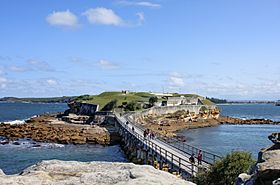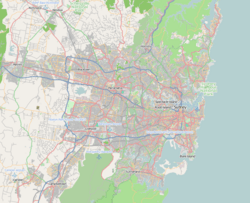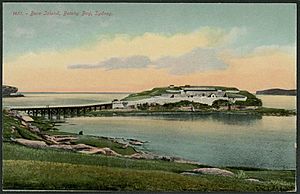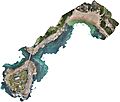Bare Island (New South Wales) facts for kids

Footbridge from La Perouse leading to Bare Island
|
|
|
Location in Sydney
|
|
| Geography | |
|---|---|
| Location | La Perouse, Sydney, New South Wales, Australia |
| Coordinates | 33°59′32″S 151°13′52″E / 33.99222°S 151.23111°E |
| Adjacent bodies of water | Botany Bay |
| Demographics | |
| Population | unpopulated |
| Additional information | |
|
Building details
|
|
| Former names | Bare Island Fort |
| General information | |
| Status | Historic site |
| Type |
|
| Construction started | 1881 |
| Completed | 1889 |
| Owner | Office of Environment and Heritage |
| Design and construction | |
| Architect |
|
| Main contractor | John McLeod, NSW Public Works |
| Official name: Bare Island Fort | |
| Type: | State heritage (complex / group) |
| Criteria: | a., c., d., e., f., g. |
| Designated: | 2 April 1999 |
| Reference #: | 978 |
| Type: | Fortification |
| Category: | Defence |
| Builders: | John McLeod NSW Department of Public Works |
Bare Island is a small, historic island located in Botany Bay, near La Perouse in Sydney, Australia. It's about 16 kilometers (10 miles) southeast of Sydney's city center. The island is famous for its old fort, which was built a long time ago to protect the coast.
Today, Bare Island is a special historic site. It was added to the New South Wales State Heritage Register in 1999. The fort is a great example of how coastal defenses were built in the late 1800s. It was designed by important engineers like Sir Peter Scratchley and James Barnet. Construction happened between 1881 and 1889.
A footbridge connects Bare Island to the mainland at La Perouse. You can only visit the old military fort and its tunnels on a guided tour. The waters around the island are very popular for scuba diving. A special type of fish, the Bare Island anglerfish, is even named after this island!
Contents
A Look Back at Bare Island's Past
Early Days and European Discovery
Long ago, Aboriginal groups like the Gweagal and Kameygal lived near Bare Island. Famous explorers Joseph Banks and James Cook wrote about it in their journals. Banks collected shells there. Cook called it a "small bare island" because it didn't have many trees. That's how it got its name, and it's one of the oldest European names for a place on Australia's east coast.
Later, Governor Phillip and French explorer Jean-Francois de La Perouse came to Botany Bay. They didn't visit the island. The French set up a small camp and garden nearby. They also buried one of their members, Father Receveur. In 1788, signs were put on the island. They told visiting ships that the main settlement had moved to Port Jackson (Sydney Harbour).
For a long time, the area around Bare Island was far from Sydney. It became a place for industries like tanneries. A unique Aboriginal community also grew at La Perouse.
Building the Bare Island Fort
In the late 1800s, Australia needed better defenses. This was especially true when Britain and Russia had problems in 1876. So, military engineers like Sir Peter Scratchley and William Jervois were sent to help. Jervois suggested a small fort in Botany Bay. It would protect Sydney from quick attacks by enemy ships.
Sir Peter Scratchley then designed the fort in detail. He worked with civil engineer Gustavus Morell. The Colonial Architect, James Barnet, helped with the plans and oversaw the building. Construction of the fort finished in 1885. Work inside the fort continued until 1889.
The Bare Island Fort shows how coastal defenses changed over time. It used new materials like concrete. It also showed how powerful new guns were becoming. The fort's design was complex, with the heaviest gun in the center. This gun faced where attacks were most likely to come from.
John McLeod's company won the contract to build the fort in 1881. He also built other forts in Sydney. The bridge to the island was added in 1887. Before that, people used a zip line or a barge to get across. The fort was armed with several large guns, including a 12-tonne cannon. About 70 soldiers lived in the barracks on the island.
In 1901, Bare Island became part of the new Australian Government. The number of soldiers was reduced. By 1908, it seemed that the fort was no longer a major military base.
From Fort to Home for Veterans
After the fort was no longer needed for defense, it became Australia's first home for war veterans. In 1912, the first seven veterans moved in. The island served as a home for veterans until 1963. However, during World War II, the army took over the fort again in 1942. The veterans moved out, and 24 servicemen, known as the "Bare section," moved in.
In the 1930s, many of the fort's guns were sold for scrap metal during the Great Depression. But the two largest guns were too heavy to move. They stayed on the island. In 1962, the army offered to sell the island to the War Veterans' Home for just one pound, but they declined.
A Museum and Historic Site
After 1963, the Randwick Historical Society took care of Bare Island. They turned it into a museum. Groups like the Fort Artillery Society would dress in old costumes. They even fired the 9-inch gun, which was a very popular attraction.
In 1967, Bare Island became a Historic Site under the NSW National Parks and Wildlife Service (NPWS). The museum continued to operate for a while. The live gun firings stopped in 1974. The fort was open to the public until 1989.
Today, the NPWS uses the island for guided tours. These tours help people learn about its history. The fort is open for guided tours on most Sundays.
Bare Island in Movies
Bare Island has even been featured in movies and TV shows! It appeared in Mission: Impossible 2, East West 101, and the finale of the Netflix show The Mole.
What Bare Island Looks Like
Bare Island is a low, rocky island. It's only about 30 meters (98 feet) from the shore of La Perouse Headland. The island's natural shape has changed a lot because of the fort. The fort complex includes the battery (where the guns were), barracks (soldiers' living quarters), a parade ground, and tunnels.
The fort was built in different stages:
- Phase I (1880–1890): This was the original construction of the fort. It included concrete work, earthworks, the bridge, and the first rooms.
- Phase II (1890–1912): More work was done, including building the barracks.
- Phase III (1912–1963): During its time as a War Veterans Home, some small changes were made.
- Phase IV (1941–1945): There isn't much evidence of changes during World War II.
- Phase V (1963–1975): When the Randwick Historical Society ran the museum, they restored some original features.
- Phase VI (1975–Present): The NPWS has done a lot of repair and conservation work. This includes fixing walls, the barracks veranda, and the drainage system.
Fun Activities at Bare Island
Bare Island is the most popular spot for scuba diving in New South Wales. On a sunny Sunday, you might see hundreds of divers there! It's also a great place for learning to dive and for snorkeling.
The reefs around the island are full of colorful marine animals. You can see amazing creatures like big belly sea horses, sea dragons, pygmy pipehorses, and red Indian fish. Sometimes, divers even spot seals and grey nurse sharks. In late winter, Port Jackson sharks are very common.
How the Fort Has Been Kept
Bare Island Fort is in very good condition. It still has most of its original parts. This means we can easily understand how it was built and how it worked. The fort's history and structure are well-preserved.
Over the years, there have been some repairs:
- 1985 to 1987: The bridge was repaired.
- 1993: Structural repairs were made.
- 1997: Major conservation work, including waterproofing, was completed.
Why Bare Island is Important
Bare Island is important because it's a nearly complete example of late 19th-century coastal defense technology. It shows how Australia, as a growing colony, worked with Britain on defense. The fort also shows how defense policy worked just before Australia became a federation.
It's also special because it was the first War Veterans Home in Australia. This shows how Australians cared for veterans of wars fought for the British Empire. The fort is also an early example of a large building made with mass concrete. This material was new and not well understood at the time.
Bare Island is important to the local community of La Perouse. It's a key part of the area's history and a popular place for recreation.
Gallery
-
A view of Botany Bay as the First Fleet arrived, with Bare Island in the background.
-
Bare Island seen from Henry Head.
See also
- List of islands of New South Wales
- Henry Head Battery
- Military history of Australia







